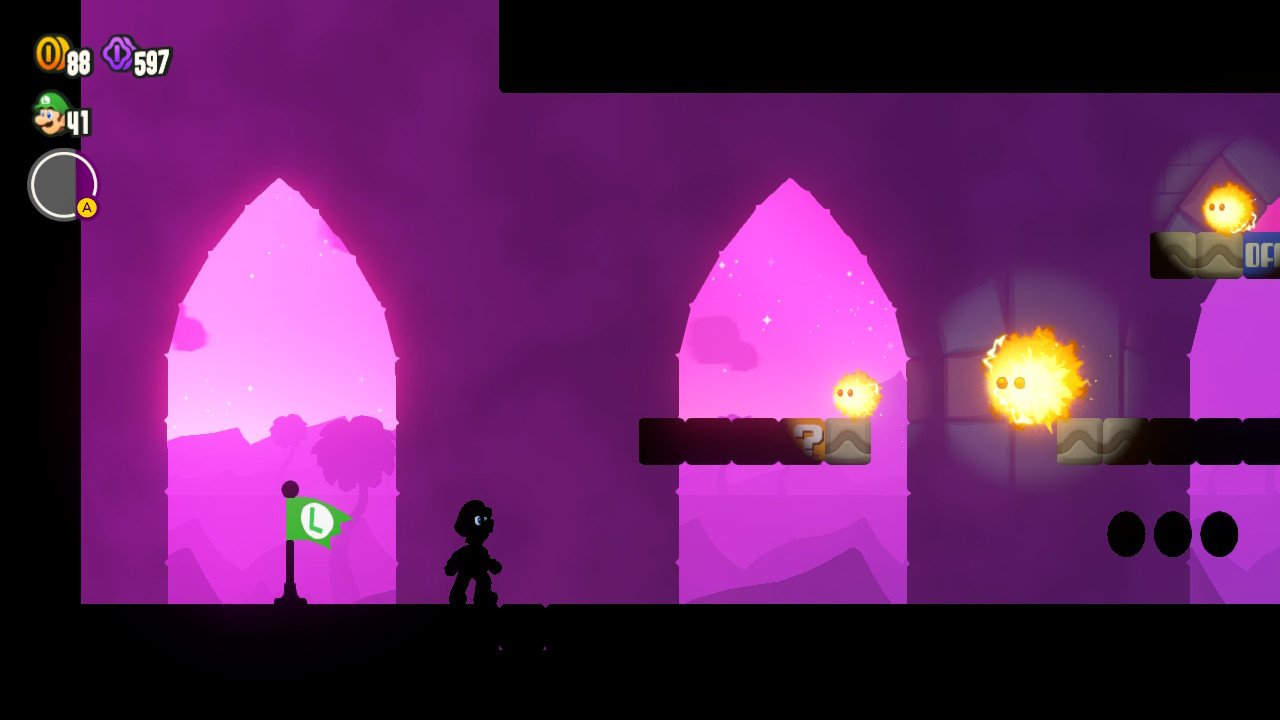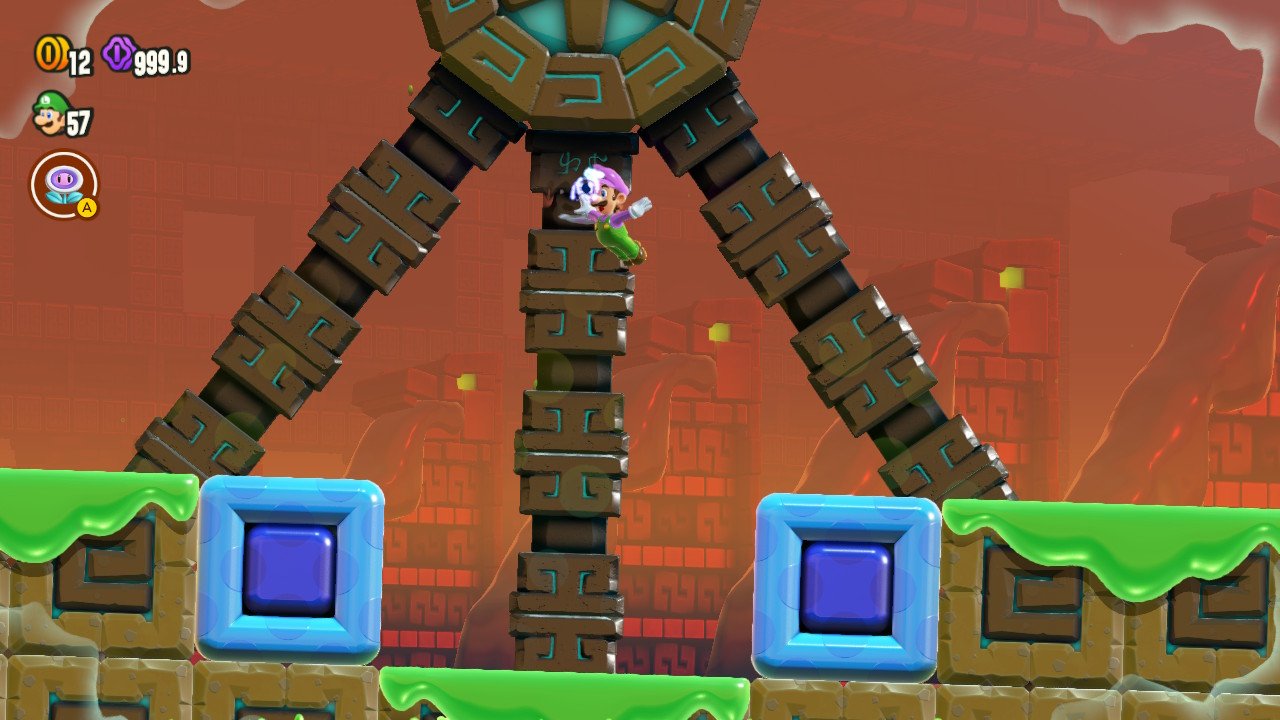Super Mario Bros. Wonder review
Wow, Nintendo has so much originality on display with this game. Although maybe it’s just a sense of relief after the monotony of all the ‘New’ Super Mario Bros titles—plus Super Mario Run—which continued to reuse all the same aesthetics and basic gameplay for like a decade. But the developers definitely put some effort into making a 2D Mario game feel unique and distinctive this time.
There’s a delightful musicality infused into Super Mario Bros Wonder. The singing piranha plants in the second stage are the first overt example of this, but it’s persistent throughout the adventure. The note blocks strongly contribute to the musical effect, plus there are mini ‘Break’ levels which play fan-favorite tunes from earlier Mario games. Then you have dance-like sequences such as Ninji Jump Party, and even the endgame showdown with Bowser that embraces the beat.
The individual lands of Super Mario Wonder are genuinely interesting and well-designed. From the fairly basic Pipe-Rock Plateau (World1) and Fluff-Puff Peaks (World2), to the more varied & interesting Sunbaked Desert (World4) and Fungi Mines (World5)—and all tied together with water-level laden Petal Isles area—there's a glorious new 2D world to be explored.
I very much enjoyed the Shining Falls area, presided over by a Master Poplin who appears to be a straight-up ninja. Also the Sunbaked Desert, with its many hidden things waiting to be discovered, it is particularly satisfying to explore. Then there’s Special World, where every single stage is an expert-level test of your platforming skills.
It’s a particularly nice touch that with the original Super Mario Bros. set in the Mushroom Kingdom, this game takes place in the Flower Kingdom. Just as the original fungus land had Toads—adorable mushroom people—walking around, the flower land is populated by Poplins—similarly cute flower people.
It’s just cool to see Nintendo expand Mario’s world to include more lands with unique flora and fauna, kind of like what they had started to do with Super Mario Land and Super Mario World back in the day. And doing a variation on the well-worn Toad theme is far more appealing here than the last time Nintendo created original plant people: the Piantas from Super Mario Sunshine. (Literally no one likes the Piantas—with their generic, Max Rebo-looking design—not even a little bit.)
Speaking of Super Mario World, Wonder is the first Mario game to actually feel like a direct sequel to the 1990 platforming masterpiece. (And yes, I am saying that SMW2: Yoshi's Island is not a true sequel to SMW. In fact, I don’t even consider that one to be part of the Mario series; it’s a Yoshi game.) Like SMW, Wonder features an adventure through a colorful new land filled with unique obstacles and enemies. Like SMW, stages in Wonder have no time limit, allowing you to explore at your own pace.
But most importantly, in Wonder you can throw held items usually a shell) straight up into the air! No 2D Mario games have allowed players to do this since Super Mario World. Despite adding acrobatic maneuvers like wall-jumps and butt stomps, the ‘New’ SMB series never let you throw objects up to hit targets directly above you.
Wonder also excels in its array of power-ups, another area where (in my opinion) the ‘New’ SMB games consistently fell flat. In addition to the prerequisite Super Mushroom and Fire Flower, this game introduces the Bubble Flower, Drill Mushroom, Elephant Fruit. Each new power-up offers a new way to traverse the world or hit targets that can make them required to reach specific goals. But more importantly, each one is legitimately fun.
If I had to pick a favorite, I’d choose the Bubble Flower, mostly because the pink-hued colors for Mario & Luigi’s bubble forms look cool as hell.
While Elephant Mario is useful and sure to be a crowd-pleaser, it is right on the edge of being a little too cute for my tastes. (To this day, I still think Cat Mario was going too far.) Just to reiterate though, I think all of the power-ups in the game are excellent. A nice little touch I noticed: If you finish a level as Elephant Mario and still have water held in your trunk, he will splash the poplin at the end, and their flower head will bloom on contact. Pretty adorable stuff.
The developers made really cool use of perspective shifts between action in the background, foreground, and the fore-foreground. And that’s just in the regular stages themselves, to say nothing of the trippy Wonder Seed effects.
The playable cast in this outing is also quite refreshing. We have Daisy playable in a mainline Mario game, FINALLY! She’s been languishing on the sidelines for ages. Two different-colored Toads and Toadette, to meet all your fungal needs. Plus four Yoshis and Nabbit for the babies who want to play too.
And don’t listen to the naysayers: The fact that all characters play exactly the same is perfect. It means you can pick anyone you want and get the same experience. So I can play through the entire game using Luigi and not have to worry about awkward floaty jumps. Or, if you actually like floaty jumps, you can equip a badge to get that wacky effect with any member of the Mario cast.
While Wonder Seed sequences might be the big crazy selling point for this game, the Badge system is actually Super Mario Wonder’s wildest element. You can equip one badge to your character before each level and it will have pretty serious effects on gameplay.
If you don’t know what badge to pick, you can have Prince Florian choose for you.
There is the Floating High Jump badge mentioned above, as well the Crouching High Jump badge, which essentially gives you the charge jump from Super Mario Bros. 2 (USA). There’s the Add ! Blocks badge which places helpful extra blocks into the level to support you, and the Safety Bounce badge which allows you to survive a fall into a bottomless pit or lava. My favorite so far is the Timed High Jump badge, which gives you a higher leap if you jump precisely when landing off a previous jump (which kind of reminds me of the triple jump from Super Mario 64). There’s even a badge that gives the player a viney grappling hook!
As might be apparent, the gameplay changes introduced by the badges can be pretty major, and there are 24 of them in total. Despite their drastic game altering effects, I don’t feel that the badge system breaks the game. Perhaps partly because they are entirely optional.
Is that Falkoshi?
In fact, to me the badge system epitomizes the looser, freewheeling design principles that make Wonder so refreshing. This time it feels like 2D Mario can break away from the stale drudgery of ‘New’ Super Mario Bros, that we can finally explore the trajectory Super Mario World laid out three decades ago. Perhaps the creativity nurtured by the Super Mario Maker generation was finally given a chance to run free at Nintendo, unrestrained by ‘New’ conventions.
Of course Wonder is not perfect. While the visual variety on display is a welcome update, the developers could have taken things even further than they did. And personally I would loved to see more levels with multiple exits. Plus with the variety of power-ups, this game could really use a ‘Secret Area’ level to quickly restock, like in Super Mario World. Once into the postgame, those silly Purple Coins become something of a chore to collect. In particular, the way the big Purple Coins are worth 10 when first collected in a level, but only worth 3 on subsequent playthroughs, is a oddly stingy move. To fully 100% complete the game, you will need to unlock all 144 Standees, which is something I had ignored the entire time. And those things cost you 30 Purple Coins a pop, so who knows if I’ll ever get around to that one.
All things considered, Super Mario Bros Wonder presents a 2D world much more concerned with delivering surprise and delight to players than simply challenging them to reach a flag pole. And it’s all the better for it.













